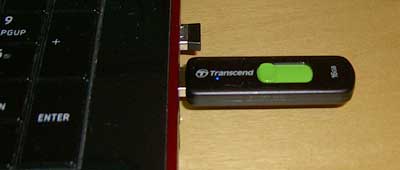Disaster Planning: USB Flash Drive

Emergency preparedness requires disaster planning. Part of your disaster plan for some of you should include a USB flash drive, specifically purposed for an emergency situation.
I said, “some of you” because I know that not everyone is into high-tech/PC’s/laptops/electronic records, etc. so this recommendation is not for everyone. But if you do partake in the modern day electronic conveniences of ‘online’, paperless records, e-books, electronic banking and bill-pay, scanning and saving important documents, personal saved information on your PC or laptop, etc., then this idea is for you…
It is amazing how much data can be stored on USB flash drives these days. In fact, just last week I purchased a
(UPDATE) Times have changed – here’s the latest model of this particular flash drive:
Transcend 64GB JetFlash 790 USB 3.1 Flash Drive
(They make it in 128 GB too)
Do you know how many documents that just 16 Gigabytes can store? Depending on the format, it could be anywhere from 10’s of thousands to hundreds of thousands of documents. It’s enough to hold about 4,000 pictures from my pocket Casio digital camera! The point is, it will hold ‘tons’.
Now imagine today’s storage capacities of 32, 64, 128 GB and up!
From an emergency preparedness and disaster planning standpoint, you could keep a purposed USB flash drive which could hold all of your important information – whatever that happens to be. In an emergency, you simply be sure to take your ‘special’ flash drive with you, and as long as the modern world hasn’t crashed down around us, it will be of some value to us during the recovery stage.
Here’s the thing though… you may want some files on the flash drive to be encrypted. It’s not terribly difficult to lose a flash drive because they are small. You wouldn’t want some stranger discovering some of your important personal information.
The first thing I do when I buy a new flash drive is to delete whatever garbage files may be on it, so I can start blank and fresh. I usually reformat it too, just in case.
Then I sometimes use a free encryption software program, like “TrueCrypt”, to encrypt some of the files that I put on the flash drive. I also keep a copy of the encryption ‘installer’ file on the same drive, so I could install it on another PC if I had to. Some encryption software programs can also create self-extracting encrypted files, which do not require a copy of the program to be installed on the PC being used to extract the files. All you need to do is remember the password.
Since your files will be encrypted, you could keep important and private documents with you, which will allow you access to all of that information should an emergency develop which requires you to grab your stuff and go…
Some of the information that you may choose to keep on the flash drive may be things like,
- A list of your passwords (we all know this can be difficult to manage)
- Account numbers and contact information for your finances
- Insurance information; account numbers, phone numbers
- Scanned copies of ID’s, license, passport, birth certificate, etc.
- Your contacts (don’t rely solely on your cell phone contacts)
- Health information; prescriptions, pharmacy, doctors
You can scan most anything today, which makes for convenient electronic storage of any data that you feel is important or may be useful later. The simple point being, give it a thought. Are there files on your computer that would spell disaster if you lost them? A little preemptive disaster planning could remedy this by keeping a backup (secured if you wish) on a USB flash drive. Now that’s ‘modern’ survival preparedness.
Oh, and before you start sending me email saying that electronic information will be useless when TSHTF, or that it will be fried when the EMP strikes, or will be worthless when the power grid goes down… Yes, yes I know – but this example is in the context of day-to-day preparedness for scenarios that are a bit more likely to bite you than ‘the big one’. There’s a place in preparedness for both.
